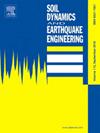A closed form solution for the generalised failure envelope of a pile group
IF 4.2
2区 工程技术
Q1 ENGINEERING, GEOLOGICAL
引用次数: 0
Abstract
New criteria have been recently proposed to construct the failure envelopes of pile groups in the force space allowing to overcome the traditional design approach involving independent calculations of the vertical and lateral group capacities, which in reality are inherently coupled. The use of such envelopes offers undeniable advantages in the Ultimate Limit State design of pile foundations under seismic or wind load. However, current methodologies postulate a double-hinged failure mechanism for the single pile within the group, which can be unrealistic along with some load paths. Recent methodologies have addressed this problem but their use in routine design still requires numerical implementation. To overcome these issues, a new, closed form solution for interaction diagrams of piled foundations based on limit equilibrium is presented and discussed. The proposed domains fully address the interaction mechanisms between the vertical, horizontal and moment loads and are constructed through a few points, associated to specific distributions of loads upon piles at failure, whose coordinates can be easily determined by hand calculation. After demonstrating the prediction capability of the approach through a comparison with rigorous 3D finite element analyses, a straightforward design procedure is introduced to assess the safety of the foundation. Finally, an application of the proposed domain to a case study of a bridge pier is presented.
群桩广义破坏包络的封闭解
最近提出了新的准则来构建受力空间中群桩的破坏包络,从而克服了传统的设计方法,该方法涉及竖向和横向群能力的独立计算,这实际上是固有耦合的。这种围护结构在地震或风荷载作用下桩基极限状态设计中具有不可否认的优势。然而,目前的方法假设群内单桩的双铰破坏机制,这在某些荷载路径下是不现实的。最近的方法已经解决了这个问题,但它们在日常设计中的使用仍然需要数值实现。为了克服这些问题,提出并讨论了基于极限平衡的桩基础相互作用图的一种新的封闭解。所提出的区域充分解决了垂直、水平和弯矩荷载之间的相互作用机制,并通过几个点来构建,这些点与破坏时桩上荷载的特定分布有关,其坐标可以很容易地通过手工计算确定。通过与严格的三维有限元分析进行比较,证明了该方法的预测能力,并介绍了一个简单的设计程序来评估基础的安全性。最后,给出了该领域在某桥梁桥墩实例研究中的应用。
本文章由计算机程序翻译,如有差异,请以英文原文为准。
求助全文
约1分钟内获得全文
求助全文
来源期刊

Soil Dynamics and Earthquake Engineering
工程技术-地球科学综合
CiteScore
7.50
自引率
15.00%
发文量
446
审稿时长
8 months
期刊介绍:
The journal aims to encourage and enhance the role of mechanics and other disciplines as they relate to earthquake engineering by providing opportunities for the publication of the work of applied mathematicians, engineers and other applied scientists involved in solving problems closely related to the field of earthquake engineering and geotechnical earthquake engineering.
Emphasis is placed on new concepts and techniques, but case histories will also be published if they enhance the presentation and understanding of new technical concepts.
 求助内容:
求助内容: 应助结果提醒方式:
应助结果提醒方式:


